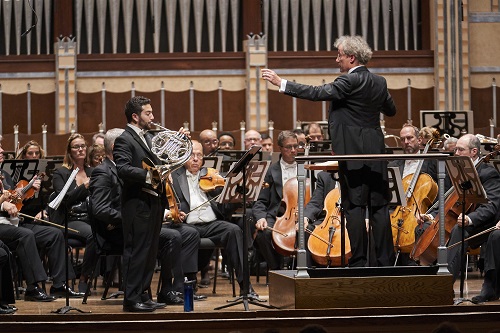 United States Neuwirth, Mahler: Cleveland Orchestra / Franz Welser-Möst (conductor), Severance Hall, Cleveland, Ohio, 26.9.2019. (MSJ)
United States Neuwirth, Mahler: Cleveland Orchestra / Franz Welser-Möst (conductor), Severance Hall, Cleveland, Ohio, 26.9.2019. (MSJ)

(c) Roger Mastroianni
Olga Neuwirth – Masaot/Clocks Without Hands
Mahler – Symphony No.5 in C-sharp minor
Fresh off the news of a five-year contract extension that will see Franz Welser-Möst in Cleveland until at least 2027, the conductor led an outstanding evening bursting with ideas both familiar and new. Lively delivery of intriguing programming bodes well for the future.
Olga Neuwirth’s Masaot/Clocks Without Hands is a fascinating world, both intensely personal and resonantly universal. Neuwirth has identified the work’s use of folkish fragments with her Jewish roots, but those fragments are scrambled by spiraling swirls of chaos. Ranging from quiet but keening swoops in the strings to hectoring blasts of brass, the ripples destabilize the folk music elements, yet can’t ultimately prevent the melodies from jelling into a high-spirited dance.
The work ends with a dissolution into silence, thanks to the eerie whistling of a bowed mallet instrument, but the after-image of vitality and humor remain and prevent the ending from feeling tragic. Like a dream, the work tells life stories outside of time, leaping from one idea to the next. It was one of the most impressive new works to appear here in recent years, and an ideal program-mate for the Mahler Fifth.
Mahler’s style changed significantly over his creative life. The relative directness and naivete of the early symphonies (Nos. 1 through 4) was upended by a new level of detail and complexity in the middle symphonies (Nos. 5 through 8), only to be replaced by a stark leanness in the late works (Das Lied von der Erde through the unfinished Symphony No.10).
In my experience, the busy, Straussian textures of the middle symphonies have been the best fit for Welser-Möst — not surprising, considering that he excels in the composer’s works. The conductor was in his element here, with a trenchant, focused Fifth full of character and inflection. Proving that one can’t pigeonhole Welser-Möst as a proponent of predictable fast tempos, he broadened the first movement, yet carefully controlled the pace and the spring of rhythms to avoid devolving into a trudge. He subtly tightened the slow tempo and rhythm until it exploded in the faster third theme, taken at an exhilarating clip. Michael Sachs’ trumpet solos were rock-solid and blazing.
The second movement picked up where that third theme of the first began. The furious tempo matched Mahler’s direction, ‘Stürmisch bewegt, mit grösster Vehemenz’ (‘Stormy and quick, with greatest vehemence’). The contrast between roaring passages and hushed moments was intensified not only by Welser-Möst’s breathtaking handling of quiet dynamics, but by his numerous in-between levels, keeping the louder parts from becoming overwhelming (except in the few moments where that is clearly what Mahler requires).
Outstanding instrumental solos — too numerous to mention — contributed to the teeming details. As a sole reservation, the climax was relentless, and didn’t allow much space for the transition through rapidly changing moods, as near-triumph is approached and then lost. But there is no question that it was compelling and exciting.
The ever-changing scherzo had ample space, with a perfectly-judged tempo that was fast enough to bring a gloriously idiomatic Viennese lilt, which buoyantly lifted phrases. Welser-Möst also brought the orchestra’s new principal horn, Nathaniel Silberschlag, to the front of the stage for his concertante solos. Silberschlag fits he orchestra’s style, and held his full power in reserve until his epic solos in the middle of the movement. There he filled the hall with a full and powerful sound that was a wonder to behold.
The Adagietto was taken at a flowing rate — quite justified from what we know of historical practice from Mahler’s protégés, Willem Mengelberg and Bruno Walter. Though the tempo worked fine, emphasizing the ardent surge, I will always confess a slight preference for a little more room to sing. The ensuing finale was full of play and mischief, at a brisk but not hectic pace. Welser-Möst’s grip was impressive. I will never forget the otherwise good performance years ago with this orchestra with Christoph von Dohnányi, in which he misjudged the energy build-up in the finale, overshooting the penultimate climax, and leaving the final pages unable to match it in excitement. No such problem here. Welser-Möst shrewdly calibrated the climaxes, making space for a further push at the end, for a thrilling close.
Welser-Möst keeps growing admirably, expanding his skills and making profound connections through insightful programming. After some initial growing pains in the early years, his partnership with the orchestra has developed a potent chemistry — one of he world’s great artistic partnerships. If he remains through the new contract extension, he will have become the longest-serving music director in the ensemble’s history, and judging by audience response, one of the most beloved.
Mark S. Jordan